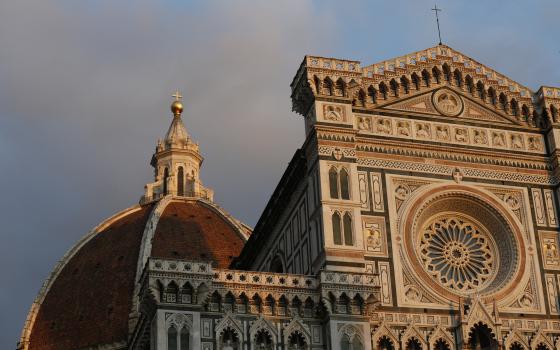In this stage of the evolution of consecrated life, we women religious have found encouragement and challenge in a variety of metaphors and images that help us make meaning of the experience. We are midwives and bridges. We are transforming like a caterpillar in a cocoon, dissolving into a gooey mess that holds the essence of a butterfly.
At a recent retreat with my own congregation, we were captivated by the story of the Duomo, the cathedral in Florence that waited 200 years for someone to come along who knew how to build its famous dome. As we considered the state of our own congregational foundation and the ongoing care it requires of us, we shared our hope that there are creative geniuses among our newest members to "do the dome."
Metaphors always helped me hope in our future when so much of our congregational energy was spent on coming to grips with letting go. I grew up on the need for new wineskins, and I was excited at the prospect of reweaving religious life at the fringes. I have poked around in the ashes for many years, confident that there was still fire somewhere. I fervently believed that "if you build it, they will come."
I can still hear Sr. Maryanna Coyle, our congregational president, telling us in the 1990s, "We are not too old, too tired or too few!" Well, now we are even older, tired-er and fewer. At every congregational meeting, we are confronted with the realities of diminishment. We desire full participation and inclusion, but that means we have to construct each meeting agenda according to our limitations. We spend less and less time grappling with the critical issues because many of us cannot fully participate in group processes.
At age 61, 10 years and three recurrences out from a diagnosis of stage 4 ovarian cancer, I wonder if it is time to live the metaphors and not just talk about them. I am impatient. I have a tremendous sense of urgency about my own life, and it carries over into my passion for the future of religious life.
What must we do to become what the metaphors suggest? We say we need to have "courageous conversations," but we rarely take the risks they require because it is just too painful. We are caught in the space between letting go and letting come, and it is a place of tension. We can hardly bear to admit that part of us is ending and will never enter the future that we are straining our eyes to see. We are afraid.
Each of us faces the fear from our particular vantage point. Those who make up the majority of our congregations wonder, "Will we be left behind when they go forward?"
The middle generations are pulled in many directions, increasingly responsible for visionary leadership, pastoral care, formation, and organizational management. They ask, "How do we hold the tension between the now and the not-yet?"
The newest members, courageous and energetic for the mission of Jesus, ask, "Will you bless us? Will you trust us? Will you send us out to create a sisterhood beyond our congregational boundaries and charisms?"
I offer two examples of how we might live the metaphors. The first is the birthing metaphor, which speaks to me of the panic that sometimes ensues during labor. As a retired family physician who attended many women during childbirth, I heard them cry out, "I don't want to do this anymore! Let's just stop now!"
In our current travails, we might prefer to go back to the comfort of what we know how to do or to delay making the changes the future requires of us. But as in childbirth, stopping is not an option. Even anesthesia, while offering relief from pain, can sometimes diminish the sensation needed to push. Birth pain has a purpose, and it can't be completely avoided without endangering the new life within or the life of the mother. So, as uncomfortable as the courageous conversations are, we must trust each other and encourage each other to give birth despite the pain.
Living the metaphor of the Florence cathedral challenges us to allow the new among us to start working on the dome while others tend the ongoing needs of the foundation. Can we do both things at once? We might fear this kind of division of labor will result in two communities: one focused on the old and one focused on the new. It can create a climate of suspicion and resentment.
This metaphor requires that we put genuine mutuality into our individual and communal discernment and decision-making, including our formation programs and processes. Too often, our future planning gets stuck in the basements of our buildings and the concern for resources that will provide security for the retirement years. We must also steward the gifts of the dome-builders whose energy and vision we ignore to our own peril. How long will we insist that our new members stand alongside us to shore up the foundations? When will we give them our shoulders to stand upon?
Living the metaphors that inspire us can assist our efforts toward genuine communal discernment. We might just gain the courage to adjust our expectations of participation so that decision-making and direction-setting is delegated to those most involved. We might be able to discern together who is called to tend the hearth and who we will send as explorers of our future.
What will it look like if we live the metaphors? Perhaps an answer can be found in the story from the desert fathers quoted by Benedictine Sr. Joan Chittister in The Fire in These Ashes:
Abba Lot went to see Abba Joseph and said, "Abba, as much as I am able, I practice a small rule, all the little fasts, some prayer and meditation, and remain quiet, and as much as possible I keep my thoughts clean. What else should I do?" Then the old monastic stood up and stretched out his hands toward heaven, and his fingers became like ten torches of flame. And he said, "Why not be completely turned into fire?"
[Sr. Janet Gildea is a Sister of Charity of Cincinnati. A retired family physician, she is Liaison for Women Religious for the Diocese of El Paso and directs women in initial formation for the Sisters of Charity.]

